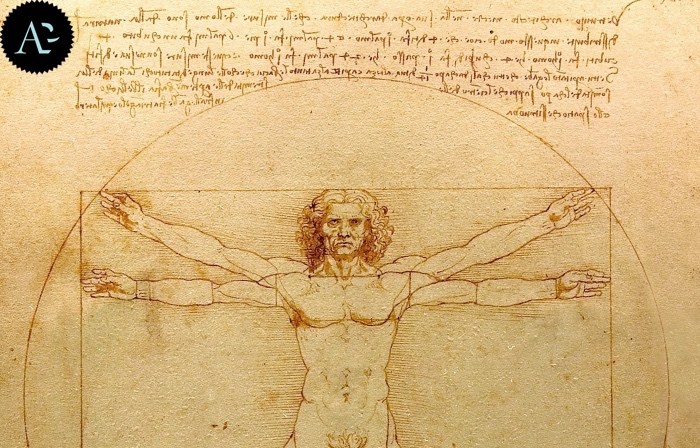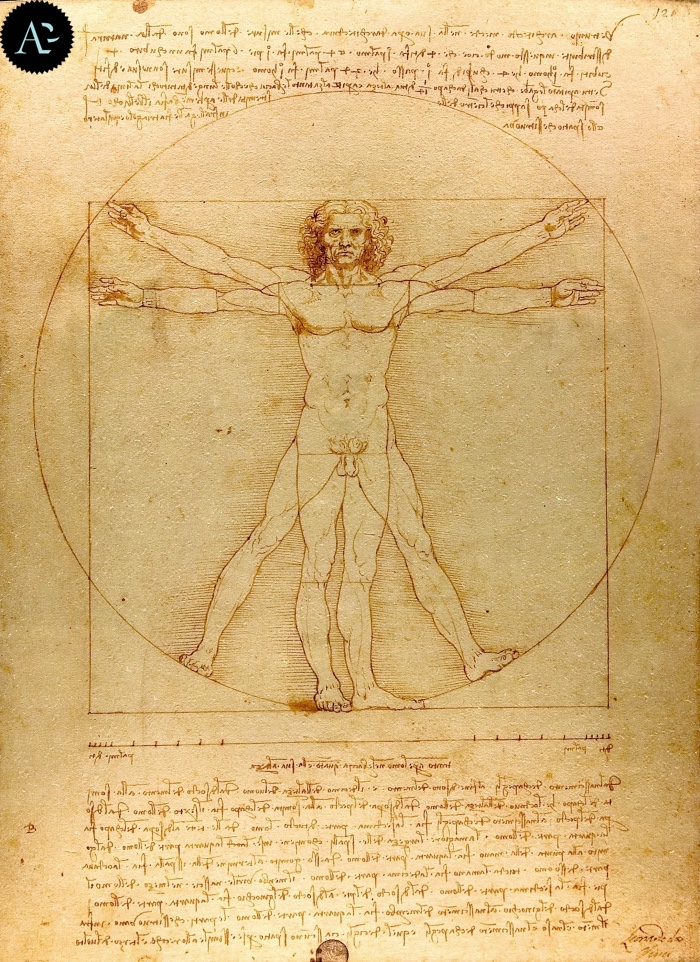
THE VITRUVIAN MAN BY LEONARDO DA VINCI: WHY IS IT CALLED THAT?
The Vitruvian Man is considered the most perfect example of symmetry, and is one of the most famous drawings by Leonardo da Vinci, the artist of Last Supper.
Every time we take a 1 € coin we can admire its perfection, but what is its meaning and its origin, and where can we admire it?
I’ll tell you everything in this post.
Why is the Vitruvian Man called that?
The Vitruvian Man is named after Vitruvius, whose essays Leonardo knew very well. The drawing was made by Leonardo da Vinci in 1490, and it’s the graphic representation of the proportions of the human body described in the treatise De architectura by the Roman architect Vitruvius (1st century BC).
The drawing depicts the image of a man perfectly inscribed in a circle and a square, and represents the relationship between the human and the divine.
Therefore, the Vitruvian Man describes the proportions of the human body geometrically, but above and below the image it is accompanied by notes written by Leonardo himself and inspired by a passage by Vitruvius, which explain the meaning of the drawing.
Perspective, proportion and anatomy are the basic elements of the Renaissance.
With the Vitruvian Man Leonardo wanted to give a mathematically measurable basis to the artistic representation, and for this reason, the written part enlarges upon the proportions of the single parts, starting from the height of the man whose center is the navel.
Leonardo lays a man down on his back, centers a compass at his navel, and draws a circle that touches the tip of his extended hands and feet.
WHY THE VITRUVIAN MAN OF LEONARDI IS PRESERVED IN VENICE
The first to write a catalog of the drawings of the Gallerie dell’Accademia in Venice was Pietro Selvatico in 1854.
The Vitruvian Man was part of a group of sheets that Francis I, Emperor of Austria, bought from the abbot Luigi Celotti in 1822 who, previously, belonged to the painter Giuseppe Bossi, the author of a famous 1810 volume dedicated to the Last Supper by Leonardo.
Bossi had received those papers, including that of Leonardo, from the heirs of a priest who had had the opportunity to take possession of the work by Cardinal Monti of Milan.
These passages have allowed Leonardo’s design to arrive in Venice from Milan, where it is still preserved with the utmost care.
Where is the Vitruvian Man?
The Vitruvian Man is exhibited on very rare occasions and is part of a collection of Leonardesque sheets preserved at the Galleries of the Academy of Venice.
The last time the Vitruvian Man was exposed to the public coincides with the celebrations for the 500th anniversary of Leonardo’s death in two different exhibitions in Venice and at the Louvre in Paris (exhibition still in progress).
Previously, the drawing was exhibited on the occasion of the introduction of the Euro, because the Vitruvian Man is reproduced on the 1 euro coin.

LINK
For more informations official website – http://www.gallerieaccademia.org


l’ho mancato per qualche giorno alla mostra di Milano! difficile recuperarlo aVenezia, ma grazie per le info!
Bisognerà aspettare qualche anno ancora per rivedere l’Uomo Vitruviano. Attendiamo e incrociamo le dita che non lo portino all’estero 😉
Esprimo solo il mio parere. Sarebbe una pazzia mandarlo all’estero. Quel disegno ha un valore inestimabile che potrebbe essere addirittura superiore a quello della Gioconda. Teniamolo stretto Sarebbe però bello poterno ammirare dal vero almeno in Italia sotto adeguatissima protezione naturalmente.
L’Uomo Vitruviano viene esposto regolarmente almeno ogni 4 anni. Era possibile ammirarlo la scorsa estate alle Gallerie dell’Accademia ad esempio. E’ vero, inoltre, che si tratta di un’opera delicata ma il suo trasporto non presenta particolari problemi perché non si tratta di un dipinto. Quindi i rischi legati al prestito dell’opera sono veramente minimi.